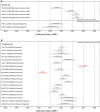Rice and millet cultivated in Ha Long Bay of Northern Vietnam 4000 years ago
- PMID: 36407601
- PMCID: PMC9666789
- DOI: 10.3389/fpls.2022.976138
Rice and millet cultivated in Ha Long Bay of Northern Vietnam 4000 years ago
Abstract
Research has generally outlined that the Neolithic East Asian farmers expanded into Southeast Asia, leading to substantial social and cultural transformations. However, the associated archaeobotanical evidence until now has been insufficient to clarify the exact timing, dispersal route, and farming package of the emergence of agriculture in Mainland Southeast Asia. To clarify these issues, the micro-plant remains of phytolith and starch from three Neolithic sites in Ha Long Bay were extracted and analyzed. This study validates the earliest evidence of co-cropping in northern Vietnam, involving the cultivation of rice together with foxtail millet at 4000 years BP or slightly earlier. Moreover, the results indicate that at least two patterns of subsistence strategy were practiced simultaneously during the initial farming phase in the region. The Trang Kenh people, a regional variant of the Phung Nguyen cultural group often have been seen as the first farmers in northern Vietnam, and they mainly practiced a cereal-based subsistence strategy with more vital cultural characteristics of southern China origin. Meanwhile, the Ha Long people, mainly composed of indigenous hunter-gatherer descendants, continued to utilize a wide range of their preferred plant resources such as taros, yams, and acorns, while they absorbed and incorporated new elements such as millet and rice into their food system. This study provides solid information to understand the diverse economic systems among different cultural groups in Vietnam.
Keywords: Ha Long Bay; Southeast Asia; Vietnam; agriculture; millet; phytolith; rice; starch.
Copyright © 2022 Wang, Nguyen, Le, Zhao, Carson, Yang and Hung.
Conflict of interest statement
The authors declare that the research was conducted in the absence of any commercial or financial relationships that could be construed as a potential conflict of interest.
Figures









References
-
- Albrecht G., Haidle M. N., Sivleng C., Hong H. L., Sophady H., Than H., et al. . (2000). Circular earthwork Krek 52/62: Recent research on the prehistory of Cambodia. Asian Perspect. 39 (1), 19–45. doi: 10.1353/asi.2000.0002 - DOI
-
- Barker G. (2005). The archaeology of foraging and farming at Niah Cave, Sarawak. Asian Perspect. 44 (1), 90–106. doi: 10.1353/asi.2005.0004 - DOI
-
- Barton H., Paz V. (2007). “Subterranean diets in the tropical rainforests of Sarawak, Malaysia,” in Rethinking Agriculture: Archaeological and Ethnoarchaeological Perspectives, 1st ed. Eds. Denham T. P., Iriarte J., Vrydaghs L. (Walnut Creek: Left Coast Press; ), 50–77.
-
- Bayard D. T. (1972). Non Nok Tha: The 1968 Excavation, Procedure, Stratigraphy and Summary of the Evidence (Dunedin: University of Otago; ).
LinkOut - more resources
Full Text Sources

